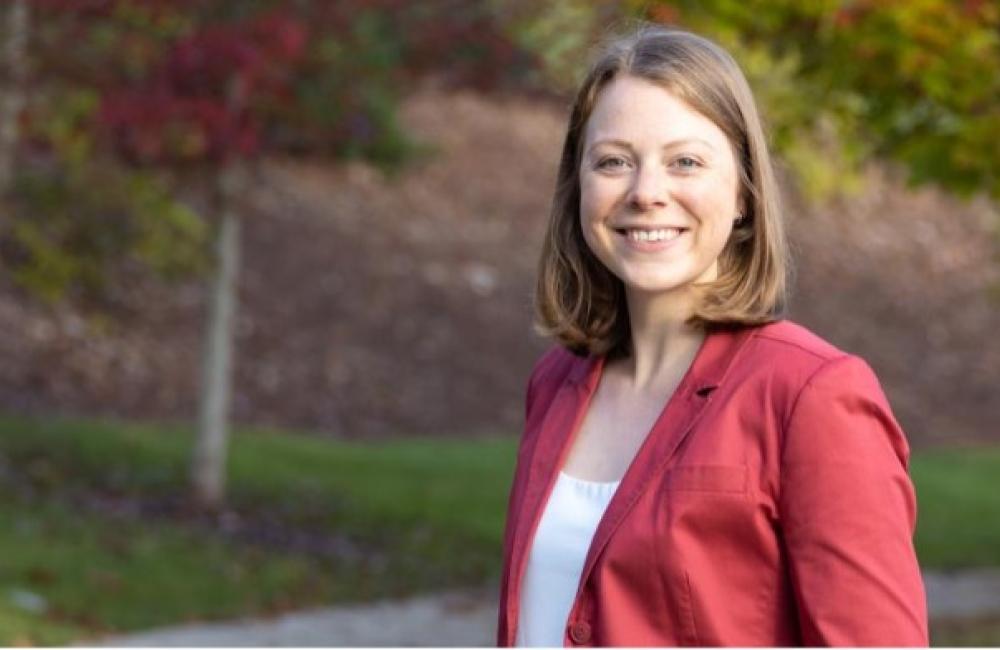
Friederike (Rike) Bostelmann is a nuclear data and reactor physics analyst at Oak Ridge National Laboratory working to advance new technology for nuclear power reactors as a clean energy source for electricity generation. Credit: Carlos Jones/ORNL, U.S. Dept. of Energy
Friederike (Rike) Bostelmann, who began her career in Germany, chose to come to Oak Ridge National Laboratory to become part of the Lab's efforts to shape the future of nuclear energy.
"What interests me most as a nuclear engineer is doing R&D that is practical, that will have an impact by contributing to a new future for electricity generation in the near-term," said Bostelmann, a nuclear data and reactor physics analyst who earned her degrees at universities in Germany and Switzerland. She worked on nuclear projects in Germany (for GRS, a nuclear safety organization) and Idaho National Laboratory before joining ORNL.
Her work at ORNL centers on modeling and simulation of non-light-water reactor systems that could potentially reshape the nuclear power industry.
"These are next-generation nuclear reactors that use different fuel forms and different coolant materials as compared to the nuclear reactors currently in use today," Bostelmann said. "They can offer significant safety and economic improvements over nuclear power plants of the past."
If adopted, the new technology of these reactors could reshape the energy supply for both electric power production and process heat for industrial needs.
"Non-light water reactors hold enormous potential to lower carbon dioxide emissions and assure the nation's future energy supply," she said.
Before the new technology can be brought online to generate electric power for the public, the reactor designs must be licensed by the Nuclear Regulatory Commission (NRC), and that's where Bostelmann's expertise plays a critical role.
"My contribution is predicting the behavior of these new systems through simulation and modeling to aid the NRC in its assessment of how safely they will operate," Bostelmann said. "As small as my role is, I am contributing to a new future of electricity generations by supporting the NRC as it evaluates these new designs for the license application process."
At ORNL, Bostelmann is part of the team behind SCALE, the modeling and simulation platform for nuclear safety analysis and design that ORNL developed in partnership with the U.S. Nuclear Regulatory Commission, the U.S. Department of Energy, and the National Nuclear Security Administration. Built over decades and encompassing a vast database of nuclear data as well as unique software, SCALE enables users to perform comprehensive analysis involving reactor physics, criticality safety, radiation shielding, and spent fuel characterization for evaluating proposed new designs for nuclear power reactors and other nuclear facilities and equipment.
For the non-light-water nuclear reactors that are the focus of Bostelmann's current work, the first demonstration is projected to go online within the next five years. Kairos Power has announced plans for a low-power demonstration reactor at the East Tennessee Technology Park in Oak Ridge. The Hermes reactor, which is a scaled version of the company's fluoride salt-cooled high temperature nuclear reactor, is scheduled to be operational in 2026.
Looking forward to seeing these new technologies deployed in the near future motivates Bostelmann in her work.
"During my senior year of high school, I was introduced to the concept of nuclear reactors for the first time in my physics class," she said. "Before I decided on my college major, I did an internship at a nuclear power plant. When the reactor was temporarily shut down for maintenance, I was able to spend two days touring areas of the reactor that regular visitors never see.
"Besides being fascinated by the technology, understanding that we could generate electricity for so many people with just one reactor was inspiring to me," Bostelmann continued. "It was the first time that I realized that I wanted to pursue a career that would eventually allow me to do application-oriented work in an area that is beneficial for many."






